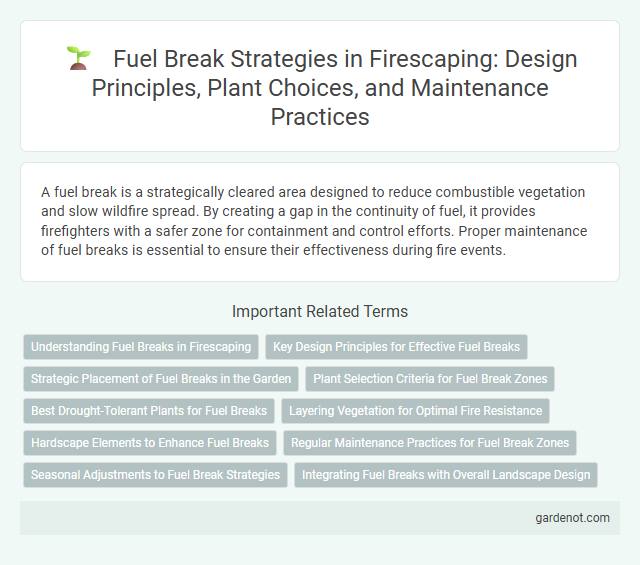A fuel break is a strategically cleared area designed to reduce combustible vegetation and slow wildfire spread. By creating a gap in the continuity of fuel, it provides firefighters with a safer zone for containment and control efforts. Proper maintenance of fuel breaks is essential to ensure their effectiveness during fire events.
Understanding Fuel Breaks in Firescaping
Fuel breaks are strategic areas where vegetation is reduced or removed to slow wildfire spread and protect structures. These zones interrupt the continuity of combustible materials, creating defensible spaces that enhance firefighting efforts. Effective fuel breaks rely on careful planning, regular maintenance, and the selection of fire-resistant plants to minimize fire intensity.
Key Design Principles for Effective Fuel Breaks
Effective fuel breaks incorporate strategic vegetation management, establishing clear zones with low-flammability plants and removing highly combustible materials to reduce wildfire intensity. Design principles emphasize sufficient width to slow fire spread, accessibility for firefighting equipment, and maintaining continuity to prevent fire from jumping gaps. Integrating native, fire-resistant species supports ecosystem balance while enhancing the fuel break's durability and ecological function.
Strategic Placement of Fuel Breaks in the Garden
Strategic placement of fuel breaks in the garden significantly reduces wildfire risk by interrupting the continuity of combustible vegetation. Positioning fuel breaks near structures, along property boundaries, and around high-value plants creates defensible spaces that slow fire spread and provide firefighters with safer access. Incorporating pathways, gravel beds, or low-flammability vegetation within these breaks enhances their effectiveness as fire barriers in landscape firescaping.
Plant Selection Criteria for Fuel Break Zones
Plant selection criteria for fuel break zones prioritize low flammability, drought tolerance, and fire resistance to reduce wildfire spread. Vegetation chosen should have minimal resin, wax, or oil content and be spaced to limit horizontal and vertical fuel continuity. Native, fire-adapted species with high moisture content and low litter production optimize fuel breaks for effective fire management.
Best Drought-Tolerant Plants for Fuel Breaks
Selecting drought-tolerant plants for fuel breaks enhances fire resistance by minimizing flammable vegetation. Optimal species include California lilac (Ceanothus spp.), manzanita (Arctostaphylos spp.), and deergrass (Muhlenbergia rigens), known for low resin content and high moisture retention. These plants create effective fuel breaks while conserving water in arid or drought-prone landscapes.
Layering Vegetation for Optimal Fire Resistance
Layering vegetation in a fuel break creates strategically spaced zones of plants with varying heights and flammability to slow wildfire spread and reduce intensity. Using low-flammability ground covers, sparsely planted shrubs, and well-maintained fire-resistant trees enhances the fuel break's effectiveness by interrupting continuous fuel sources. Properly designed vegetation layers also improve moisture retention and airflow, further increasing fire resistance.
Hardscape Elements to Enhance Fuel Breaks
Hardscape elements such as gravel pathways, stone patios, and concrete driveways create effective fuel breaks by reducing flammable vegetation near structures. Incorporating non-combustible materials interrupts fire flow and limits fuel availability, enhancing fire resistance in landscaping design. Strategic placement of these features not only improves safety but also complements aesthetic appeal and property function.
Regular Maintenance Practices for Fuel Break Zones
Regular maintenance practices for fuel break zones include consistent removal of dead vegetation, pruning low-hanging branches, and mowing grasses to reduce combustible materials. Employing controlled grazing and periodic inspections ensures fuel breaks remain effective in slowing wildfire spread. Maintaining these zones with prescribed burns and debris clearing minimizes wildfire intensity and enhances landscape resilience.
Seasonal Adjustments to Fuel Break Strategies
Seasonal adjustments to fuel break strategies enhance fire management effectiveness by addressing variations in vegetation moisture and growth rates throughout the year. Implementing tailored fuel treatments during dry seasons reduces combustible material, minimizing wildfire intensity and spread. Adapting fuel breaks seasonally supports ecosystem resilience and promotes safer landscapes in fire-prone regions.
Integrating Fuel Breaks with Overall Landscape Design
Integrating fuel breaks with overall landscape design enhances wildfire defense by strategically reducing combustible vegetation while maintaining aesthetic and ecological value. Effective fuel breaks combine fire-resistant plants, hardscape elements, and natural barriers to create continuity between fire-safe zones and the surrounding environment. This holistic approach not only mitigates fire risk but also supports habitat preservation and landscape resilience.
Fuel break Infographic

 gardenot.com
gardenot.com